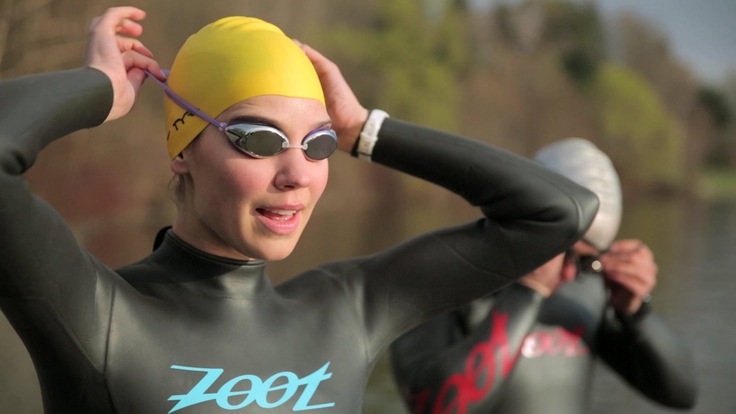So you want to try a triathlon—a sprint or mini, Olympic or international, half Ironman or even an Ironman. Good for you, and good luck!
All triathlons consist of swimming, cycling and running. One key to a good race is to have the right gear. Here's an overview of what to consider.
Getting Started
Triathlons come in varying distances. If this is your first tri, it's usually best to start with a Sprint then work your way up to longer events later.
| Swim | Cycling | Run | ||||
|---|---|---|---|---|---|---|
| kilometer | mile | kilometer | mile | kilometer | mile | |
| Sprint | 0.3-0.75 | 0.24-0.62 | 8-25 | 5-15.5 | 1.5-5 | 1-3 |
| Olympic | 1.5 | 0.93 | 40 | 24.8 | 10 | 6.2 |
| Half Ironman | 1.9 | 1.2 | 90 | 56 | 21.1 | 13.1 |
| Ironman | 3.8 | 2.4 | 180.2 | 112 | 42.2 | 26.2 |
Consider joining a triathlon training group in your area and/or a swim team to get prepared. See the REI Expert Advice article, Triathlon Training Tips, for more information.
Clothing for a Triathlon
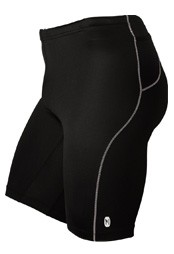
You can opt to change into clothes specific to each leg of the race—or not.
Some triathletes choose to do the whole race in a swimsuit for quicker transitions. Other swimmers simply pull on a pair of shorts before jumping on their bike. Still others change at each transition, especially in long races such as an Ironman, where seconds don't mean as much as comfort.
One popular option are triathlon-specific shorts ("tri shorts"), shown at right. These shorts (some include tops to be racesuit-style) work well for all 3 stages of a triathlon.
Tri shorts wick away moisture and dry quickly. Many offer enhanced ultraviolet (UV) sun protection. The racesuit and shorts have a chamois pad that is thinner than a regular bike-short chamois so it is more comfortable for the running stage. (As you might imagine, running in regular bike shorts would be really uncomfortable.) In general, tri clothing should fit snugly.
Tri Swimming Gear
The swim is generally the first leg of any triathlon. For this phase, a wetsuit, cap and goggles will make your swim a lot more enjoyable and efficient. If you are a minimalist or if the water temperature is above 84°F (the governing body, USA Triathlon or USAT, doesn't allow wetsuits over 84°F), your only necessity is a swimsuit.
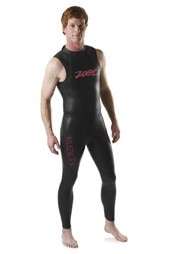
Wetsuit
A wetsuit increases your buoyancy and reduces drag so you can get a faster time in the swim segment. It can also be a necessity if you are swimming in cool conditions. While some water gets inside a wetsuit (hence its name), this quickly gets warmed by your body heat to help insulate you. The main downside of a wetsuit is the time it takes to exit one during the swim-to-bike transition (T1).
What type of wetsuit is best? Your choices include sleeves or no sleeves; shorty style or full length; 1-piece or 2-piece. The air and water temperatures you expect during your swim can help guide you to a suitable style of wetsuit. Keep in mind, too, that the number of zippers on a suit correlates closely to how much water is retained.
While any wetsuit should work OK, triathlon-specific wetsuits are lighter, more efficient and give less resistance while swimming. In a USAT-sanctioned race you'll need to make sure you're using a USAT-approved wetsuit.
Fit: A wetsuit needs to be the right length in the arms, legs and the neck-to-crotch area so these areas do not bulge. Bulges allow water to collect, which slows you down. A wetsuit should fit snugly and have enough stretch to allow good shoulder mobility. It should not be so tight that it's restrictive and chafes the neck. If you can't fit into a 1-piece properly, go with a 2-piece model.
Care: After the race, rinse the wetsuit inside and out with fresh water, then lay it flat or hang it to dry. Avoid long exposure to sunlight.
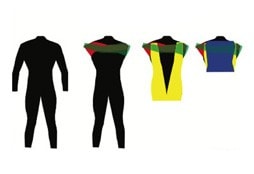
Storage: Lying flat is the best way to store a wetsuit. Fold the arms to the opposite shoulder, fold the legs to the shoulders and fold the waist to the shoulders. If using a hanger, try to use a thick hanger to avoid pressure on the shoulders. Drape the legs over the hanger and you're done.
Swim Cap
A swim cap is often provided by race organizers. If using your own, there are 3 common materials used: latex, silicone and Lycra® spandex. Attributes include:
| Latex | Silicone | Lycra |
|---|---|---|
| Thin | Thicker | Swimsuit material |
| Least durable | Moderately durable | Most durable |
| Inexpensive | Moderate price | Moderate price |
| Color can match your suit | Won't pull your hair as much | Won't pull hair |
| Tends to stick together | Resists sticking | Resists sticking |
| Less drag | Less drag | More drag |
| Cooler than silicone | Warmer than latex | Won't keep hair dry |
Those who have a shaved head can go without a swim cap. In some races, though, your race number is written on the cap, so you probably will want to wear one rather than have indelible ink on your noggin.
Tip: If using a latex cap, sprinkle some baby powder in it before storing. It'll help keep it from sticking together.
Goggles
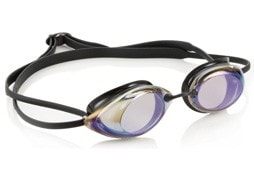
To swim comfortably with your eyes open, get a pair of goggles. The curved lenses also enhance your peripheral vision and filter UV rays.
Your main consideration should be fit. Even though goggles are adjustable, different brands and models fit faces differently.
Fit tips when trying on goggles:
- First, hold the eyepieces to your eye sockets to see if the size of the lenses feels comfortable.
- Adjust the nosepiece (some don't have this) to fit accordingly. You can cut off any excess later.
- The strap should sit just above your ears.
- If there are 2 straps, the top one should go over the upper back of your head.
- Adjust the straps so the goggles fit snugly and have no gaps around the edges. There should be a slight vacuum seal, but they should not fit so tightly that they hurt.
Swim-goggle straps can be worn either over or under the cap. Some triathletes put them under the cap to deter someone kicking them off.
Most goggles use an anti-fog technology, but if you still have problems a fog cloth or lens cleaner can be used.
| Lens Color | Effect |
| Clear | Clear vision, no change of colors |
| Smoke | Reduces light transmission and lowers brightness without much color change |
| Blue | Reduces glare and gives good visibility in bright light |
| Yellow/Orange/Red | Eliminates blue; good for indoor pools |
| Mirrored | Reduces brightness and glare |
Tip: It's good to have an extra pair of goggles on hand and/or different shades of lenses for sunny versus cloudy days.
Earplugs and Nose Plugs
If you want to keep water out of your ears, consider a pair of soft silicone earplugs. The same goes for your nose—use a nose plug if desired to keep water out of your nose.
Tri Cycling Gear
Bicycle
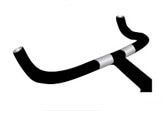
Most types of bikes—mountain, road or triathlon-specific—are fine to compete in a triathlon. It just depends on your budget and your desire for speed. Of course, your speed also depends mightily on your fitness level.
For maximum versatility: If you want to enjoy all-purpose riding but still have good speed for triathlons, choose a road bike. You can use it for triathlons, road rides, commuting or errands. You can also choose from a huge selection of bikes and pricing. To make a road bike more efficient for triathlons, you can add components like aero bars or bullhorn bars (shown at right) and disc wheels. Your REI bike shop can order parts to upgrade the components.
For maximum speed: If triathlons are going to be regular events for you and you have sufficient budget, consider a triathlon-specific bike. These bikes put you farther forward over the front wheel than other types of bikes. They are more aerodynamic and work your hamstrings more efficiently, which helps your legs in the run phase. The downsides? These bikes are more difficult to maneuver for general cycling, they don't have drop handlebars, they can be uncomfortable for long rides and their braking is not as convenient. To see REI's tri-bike selection, search on "triathlon bikes" on REI.com.
For trail riding: A mountain bike is slowest on the roads, but if your triathlon is on trails it becomes a necessity. For more speed on the road, you can always change out your knobby tires for slick ones.
For more help selecting a bike, see the REI Expert Advice article on How to Choose a Bicycle.
Bike Shoes
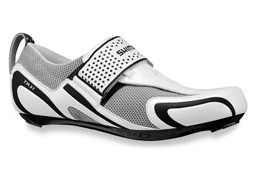
Stiff-soled cycling shoes give you far more power than running shoes do. And so-called "clipless" cycling shoes (those that attach directly to the pedal) provide the most pedaling efficiency.
For triathlon use, look for shoes that offer easy on/off for faster transitions.
- Shoes that have 1 or 2 hook-and-loop strap closures generally allow faster change-outs than shoes with laces.
- Look for a loop at the top-back of the heel—it helps you pull the shoe on more easily.
Helmet
Any helmet will do as long as it is approved by the Consumer Products Safety Commission (CPSC)—fortunately, this is true of virtually all helmets sold in the U.S. these days. A mid- to upper-level road bike helmet offers more vents and is more aerodynamic—2 qualities that are useful for triathletes.
Tip: Try on the helmet with your sunglasses to make sure they're compatible.
Socks
To make a transition even faster, some racers opt to go sockless. This is not something to try for the first time on race day. Practice this many days earlier. Go to a track and run a couple of laps. That way if you need to put on socks they'll be nearby.
If you have any fear of getting blisters from heat, moisture and friction, you'll be glad you took time to put on socks before you hop on the bike. Nothing is worse than getting blistered, sore and bloody feet while riding your the bike and then still having a run ahead of you.
Sock thickness is largely a personal preference; just make sure the socks are made of moisture-wicking materials (merino wool or synthetics).
Tip: If you go sockless, try putting powder, lubricant and/or duct tape on potential hotspots on the inside of your shoes.
Sunglasses
Remember to take off your swim goggles before hopping on the bike. Replace them with a pair of sunglasses. They'll block wind, UV rays and glare.
Some glasses have interchangeable lenses for different conditions. You just have to plan or guess what the weather will be on the ride and run when setting up your gear. If you don't want to take any chances, look for sunglasses that have photochromic lenses. These automatically transition from light to dark conditions.
Tools
Hopefully you'll breeze right through the bike leg, but you just never know if you'll get a flat. That's why it's always good to be prepared. While some races have support along the course, with your own tools you know you won't have to wait for help.
On the bike have:
- 2 extra tubes
- 2 or 3 tire levers
- Bike multi-tool
- CO2 cartridge and/or hand pump
Cycling Gloves
Should you use them? It's a matter of personal comfort whether you feel it's worth the time to put them on. One tri-specific strategy: Attach your gloves to the handlebar with hook-and-loop straps and put them on once you hit the road.
Race Belts
If you don't want to mess with safety pins, use a race number belt and shave off some seconds, too. Attach your race number to this elastic belt when you set up so it's ready to grab and go.
Nutrition
Free food at the race usually depends somewhat on the list of sponsors. Typically, race organizers provide bananas, cereal products, cookies, some kinds of protein or energy bars, gels and drinks. Bringing your own snacks and beverages versus taking what's available along the course is a personal decision. If you choose to carry your own, there are several ways to do so:
- Water or beverage: Traditional water bottles fit into standard water-bottle cages on your bike. Triathlon-specific bottles have a straw for hands-free sipping while cycling and a mesh plug for quick refilling. They slip into some types of aero bars; otherwise you can use special brackets that clip onto any handlebar.
- Food storage: Some riders use a cycling jersey and stash snacks in the rear pockets. Others tape their energy gels onto the handlebar. Still others attach small hook-and-loop holders to the handlebar that are large enough to hold their energy goodies.
Tri Running Gear
Running Shoes
For help in selecting running shoes that are best for your style of running, see the REI Expert Advice article, Running Shoes: How to Choose.
If you're doing a shorter triathlon, racing flats may be fine. But for longer distances, you'll probably want the support, cushion and comfort of training shoes.
One tri-specific piece of shoe advice is to use toggles or stretch laces to shave off some seconds from your time.
- Toggles are put on your shoestrings to cinch the laces tight quickly. Once the toggle is on, just cut the laces shorter or secure the laces to a lower section of the shoestring so they don't flop around while you're running.
- Stretch laces are elastic-like laces that have toggles. The laces stretch for easy on/off; just tighten the toggle for security.
If you took the time to put socks on during the first transition (T1), you can leave on the same socks during the second transition (T2) and keep going. Or you can have a fresh pair ready at T2 along with your running shoes.
Running Pack (Hydration Belt)
There are typically many aid stations along any tri course, but if you want more control over what you consume and when, consider using a running pack or hydration belt. These come in a wide variety of styles, with bottles and flasks that are lightweight and runner friendly.
Hat
Whether it's hot or cool, you may want to wear a hat or visor. It can shade your face from the sun, shield your eyes from rain and help keep sweat out of your eyes.
Fitness Monitor
Of course, all stages of the race will be timed and recorded, but a fitness monitor is a useful accessory. A fitness monitor helps you assess your body energy and race strategy at any given moment—not just at transitions where your split time is called out.
There are 3 types of monitors that can help you during training or racing.
- A simple chronograph watch helps you watch your overall time and splits.
- A heart-rate monitor lets you select your heart-rate exercise zone and set an alarm to warn you if you go outside of that zone.
- A speed and distance monitor helps you determine how far you have gone and how fast you are going.
See the REI Expert Advice article on How to Choose a Fitness Monitor to learn more.
Pre-race Gear
You're going to have a lot of gear to carry to the staging area. There are triathlon-specific carrying bags, but a duffel bag or backpack also works well to carry everything. Just make sure the duffel bag has a strap you can sling over your shoulder so you can maneuver your bike at the same time.
See our comprehensive triathlon checklist for the gear you need to have with you.
Lube
Triathlons are often long and demanding. To increase your comfort, lubricate your body (and/or any gear that may rub against you) with an anti-chafing product. Do this during each stage of a triathlon. In a short event such as a sprint, lube may not be as necessary, but for all longer races you will definitely appreciate it.
Swim phase: To help your wetsuit slip on easier, lube from elbows to wrists, knees to ankles and across your feet. At a minimum, put some lube on your wrists, feet and ankles. You should also lube any high-mobility areas such as your neck, shoulders and armpits—anywhere that rubbing is likely.
Bike phase: Use a chamois cream on the pad of your shorts or directly on skin, and use an anti-chafing product on the bike seat, shorts, your thighs and/or any skin where there can be friction. If you go sockless, lube the shoes beforehand and lube your feet.
Men's nipples and women's bra lines tend to be the areas that need lubrication during the run. If you go sockless, pre-lube your shoes and lube your feet again. Also, consider lubing your thighs and arms.
First Aid
Race organizers always have first-aid stations available, but it is a good idea to be personally prepared for minor cuts, blisters and crashes. Keep these supplies at your transition area, and consider taking a few bandages and a mini-sized antiseptic gel with you on your bike and hydration belt.
Sunscreen
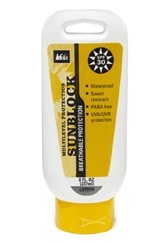
Whether skies are sunny or gray, damaging ultraviolet (UV) rays are everpresent. There are 2 main types of UV rays: UVA rays can lead to premature aging and skin cancer (tip: UVA = Aging); UVB rays can cause sunburn and also skin cancer (tip: UVB = Burning).
People with most skin types should use a waterproof sunscreen of SPF 30 or higher (sun-sensitive individuals should wear SPF 50). Apply it before you leave home or at least 30 minutes prior to sun exposure so it can absorb into your skin and create a layer of protection. After you get numbered for the swim, you may want to apply more (allow it to dry before putting on the wetsuit). You should also generously reapply during each subsequent stage. Even though a sunscreen may be labeled as waterproof, it doesn't mean you won't rub or sweat it off. Don't forget your lips and ears, too.
Nourishment
The night before: Hydrate, but don't drink so much that you're up all night in the bathroom. Eat foods that are easy to digest. Avoid processed foods or those high in fat and fiber as they are slow for your body to process. You probably don't want to eat a large meal in the 12 hours prior to the race. Alcohol dehydrates you, so take it easy on the libations and stick to water and/or sports drinks.
Race-day morning: You'll want some kind of nourishment before the race, and if your stomach can handle solids eat a carbohydrate. Otherwise, you might try a liquid that is easier to digest. Either way, eat at least 2 hours prior to the race to get it through your system and stay out of the portable toilets on the racecourse.
During: Drink water or energy drinks that restore electrolytes, calories and fluids to give you energy during your race and help prevent lactic acid from building up in muscles. Especially during an Ironman, you should eat energy snacks or gels for energy during the bike and run legs.
Post-race: Within 30 minutes of finishing, start rehydrating and replacing electrolytes. Eat some carbohydrates and protein like a bagel and banana. This helps to reduce cramping.
For more information on nourishment and foods see the REI Expert Advice article on How to Choose Energy Foods.
Sleeves (Arm Warmers)
Thermal sleeves are a good option for sunny and/or cool days. On sunny days, these sleeves protect your skin from damaging UV rays. On cool days, they provide extra insulation.
Tip: A vest or long-sleeved shirt is also a good item to have at your transition areas—both are easy to throw on or off according to the weather.
Compression Clothing
Compression-style triathlon clothing or a compression layer under your triathlon clothing is designed to reduce muscle fatigue and encourage faster muscle recovery.
The theory is that lactic acid builds up in your body during strenuous activity. This contributes to fatigue, soreness and weariness. Compression clothing is designed to improve blood flow, increase circulation and flush lactic acid more rapidly to enhance recovery.
Compression clothing intended for triathlons should not be confused with medical compression clothing which is more confining and can restrict blood circulation if worn during physical activities.
REI carries a line of Zoot CompressRx technical compression apparel including tops, bottoms and socks that use technology adapted from the medical compression field. This clothing is designed to wick moisture, dry fast, help control body temperature and offer UV protection.
Race Day Tips
To get ready for the race itself, see the REI Expert Advice article on Triathlon Race Day Tips.
